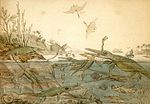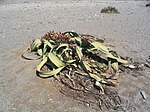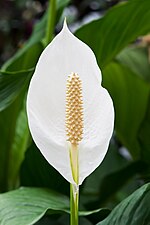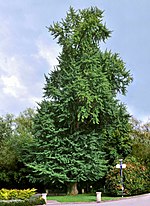fossil history of flowering plants records the development of flowers and other distinctive structures of the angiosperms, now the dominant group of plants...
27 KB (2,894 words) - 05:16, 17 June 2024
Flowering plants are plants that bear flowers and fruits, and form the clade Angiospermae (/ˌændʒiəˈspərmiː/), commonly called angiosperms. They include...
79 KB (6,233 words) - 21:17, 12 July 2024
the complex seed-bearing gymnosperms and angiosperms (flowering plants) of today. While many of the earliest groups continue to thrive, as exemplified...
136 KB (16,963 words) - 16:45, 9 August 2024
Paleobotany (redirect from Fossil plants)
evidence of vegetation away from areas of sedimentation. Plant fossils almost always represent disarticulated parts of plants; even small herbaceous plants are...
28 KB (2,954 words) - 01:53, 7 August 2024
resembling those of modern cryptogamic plants and vascular plants first appeared in the fossil record from the Late Ordovician. These plants probably resembled...
22 KB (2,737 words) - 00:38, 2 July 2024
Catalpa (section List of species)
called catawba, is a genus of flowering plants in the family Bignoniaceae, native to warm temperate and subtropical regions of North America, the Caribbean...
9 KB (974 words) - 00:12, 15 August 2024
living fossil is an extant taxon that phenotypically resembles related species known only from the fossil record. To be considered a living fossil, the...
47 KB (4,928 words) - 04:33, 21 August 2024
flower-like structures. The group contained the angiosperms - the extant flowering plants, such as roses and grasses - as well as the Gnetales and the extinct...
33 KB (2,769 words) - 00:06, 1 November 2023
some non-flowering plants such as mosses, the sexual gametophyte forms most of the visible plant. In seed plants (gymnosperms and flowering plants), the...
95 KB (8,045 words) - 11:03, 11 August 2024
Ginkgo (category Permian plants)
Ginkgo is a genus of non-flowering seed plants. The scientific name is also used as the English name. The order to which it belongs, Ginkgoales, first...
14 KB (1,441 words) - 05:15, 14 August 2024
Botany (redirect from Study of plants)
which some 391,000 species are vascular plants (including approximately 369,000 species of flowering plants), and approximately 20,000 are bryophytes...
137 KB (14,760 words) - 15:47, 20 August 2024
Paleontology (redirect from Fossil taxon)
and diversity, and some took to the air and the sea. Fossil evidence indicates that flowering plants appeared and rapidly diversified in the Early Cretaceous...
102 KB (10,187 words) - 03:20, 15 July 2024
plant that produces seeds. It is a category of embryophyte (i.e. land plant) that includes most of the familiar land plants, including the flowering plants...
15 KB (1,368 words) - 21:57, 28 June 2024
Fossil Forest is a palaeobotanical site near Brymbo, Wrexham County Borough, Wales. It is known as a significant area of Early Carboniferous fossils,...
6 KB (601 words) - 02:11, 29 November 2023
ago, right around the time that eudicots—the plant group that comprises 75 percent of flowering plants—started branching out. The results, which confirm...
85 KB (4,725 words) - 15:06, 9 August 2024
fossil evidence that flowering plants diversified rapidly in the Early Cretaceous, from 130 to 90 Ma, and that their rise was associated with that of...
233 KB (22,592 words) - 04:19, 20 August 2024
Nymphaeaceae (category Aquatic plants)
Nymphaeaceae (/ˌnɪmfiˈeɪsi.iː, -ˌaɪ/) is a family of flowering plants, commonly called water lilies. They live as rhizomatous aquatic herbs in temperate...
27 KB (2,751 words) - 17:19, 9 August 2024
The history of paleontology traces the history of the effort to understand the history of life on Earth by studying the fossil record left behind by living...
64 KB (8,410 words) - 07:57, 6 August 2024
Nymphaeales (category Early Cretaceous plants)
The Nymphaeales are an order of flowering plants, consisting of three families of aquatic plants, the Hydatellaceae, the Cabombaceae, and the Nymphaeaceae...
17 KB (1,263 words) - 12:05, 5 March 2024
Gnetophyta (category Plant divisions)
presence of vessel elements, a system of small tubes (xylem) that transport water within the plant, similar to those found in flowering plants. Because of this...
40 KB (4,072 words) - 03:23, 17 August 2024
Basal (phylogenetics) (section Flowering plants)
insight into the evolution of flowering plants; for example, it has "the most primitive wood (consisting only of tracheids), of any living angiosperm" as...
36 KB (3,959 words) - 08:27, 14 April 2024
angiosperms (flowering plants). They are contrasted with nonvascular plants such as mosses and green algae. Scientific names for the vascular plants group include...
24 KB (2,051 words) - 20:34, 15 August 2024
Monocotyledon (redirect from Monocotyledonous Plants)
grass-like flowering plants (angiosperms), the seeds of which typically contain only one embryonic leaf, or cotyledon. They constitute one of the major...
115 KB (11,098 words) - 12:35, 26 July 2024
naturalised in other parts of the world; in particular, the date palm's long history of cultivation means that escaped plants in the past have long-since...
15 KB (1,318 words) - 06:36, 18 April 2024
The fossil record of the family, mostly represented by pollen such as Clavatipollenites, extends back to the dawn of the history of flowering plants in...
13 KB (1,260 words) - 07:08, 22 April 2024
Araceae (section Fossil record)
The Araceae are a family of monocotyledonous flowering plants in which flowers are borne on a type of inflorescence called a spadix. The spadix is usually...
19 KB (1,944 words) - 18:39, 1 July 2024
Pteridospermatophyta (category Prehistoric plants)
polyphyletic grouping of extinct seed-producing plants. The earliest fossil evidence for plants of this type are the lyginopterids of late Devonian age....
18 KB (1,595 words) - 23:25, 18 August 2024
Ginkgo biloba (category Garden plants of Asia)
time, flowering plants with better adaptations to disturbance displaced Ginkgo and its associates.: 93 At the end of the Pliocene, Ginkgo fossils disappeared...
65 KB (7,004 words) - 01:53, 18 August 2024
Hell Creek Formation (category Natural history of Montana)
wet ground of the dense woodland, the diversity of angiosperms and conifers were present. An great diversity of herbaceous flowering plants, ferns and...
46 KB (4,521 words) - 14:51, 2 August 2024























